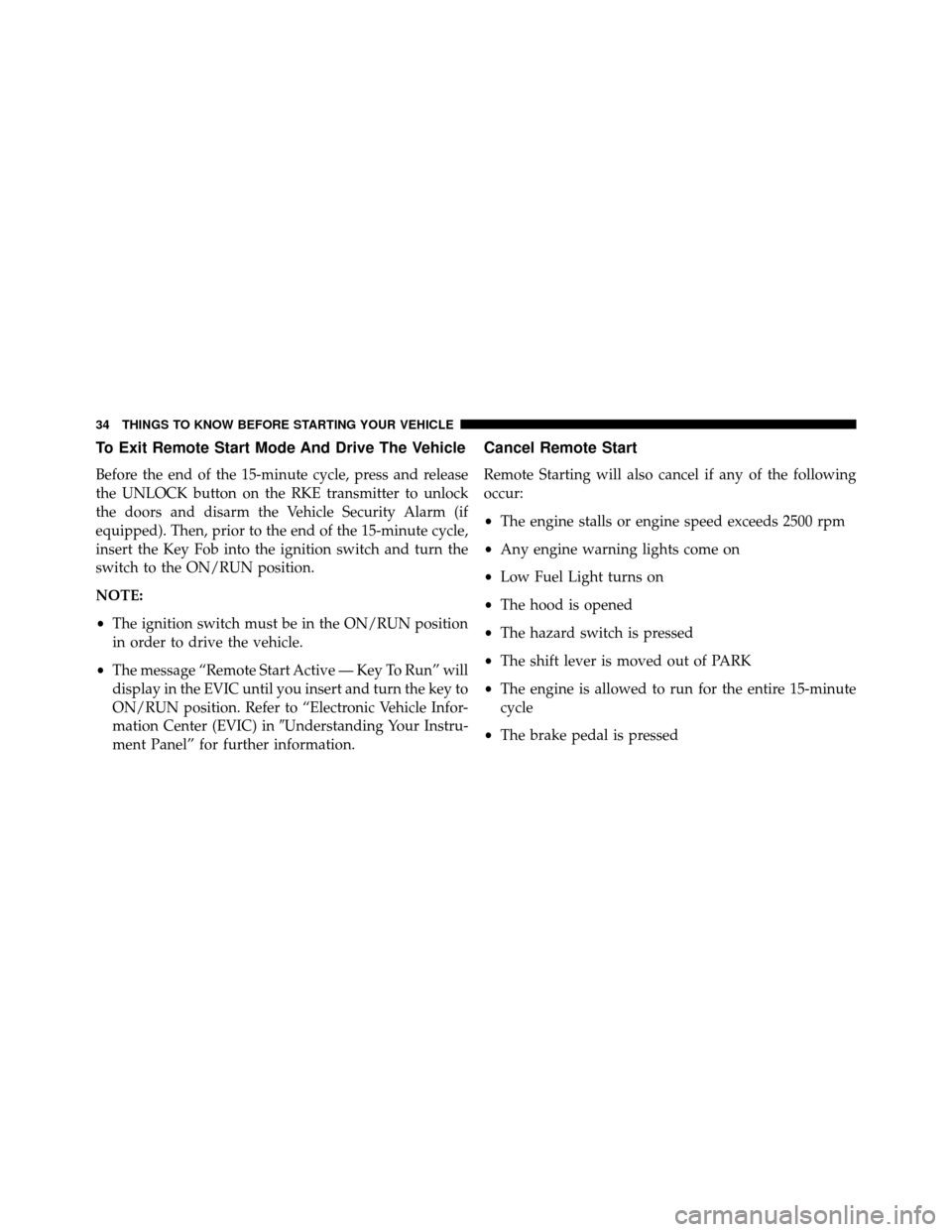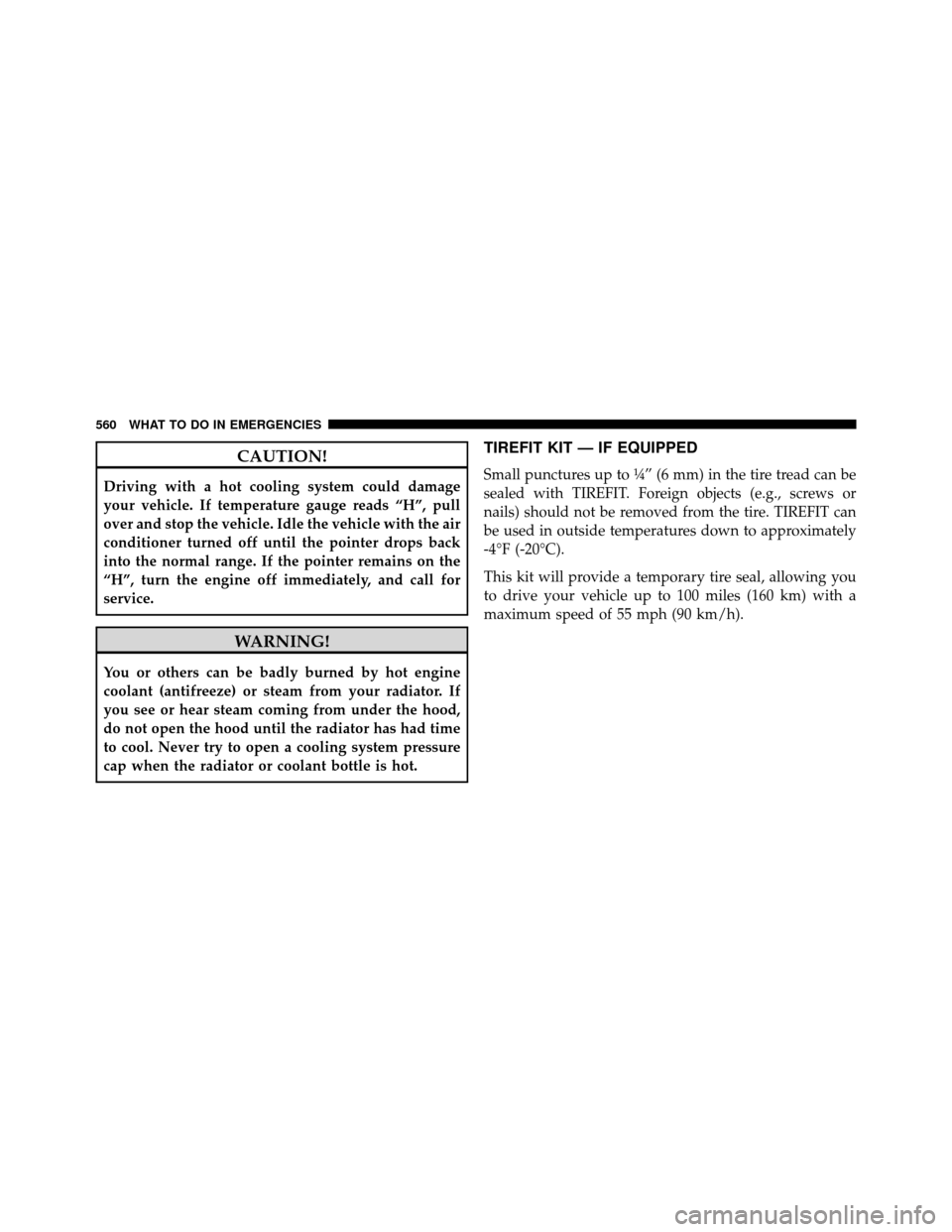Page 36 of 698

To Exit Remote Start Mode And Drive The Vehicle
Before the end of the 15-minute cycle, press and release
the UNLOCK button on the RKE transmitter to unlock
the doors and disarm the Vehicle Security Alarm (if
equipped). Then, prior to the end of the 15-minute cycle,
insert the Key Fob into the ignition switch and turn the
switch to the ON/RUN position.
NOTE:
•The ignition switch must be in the ON/RUN position
in order to drive the vehicle.
• The message “Remote Start Active — Key To Run” will
display in the EVIC until you insert and turn the key to
ON/RUN position. Refer to “Electronic Vehicle Infor-
mation Center (EVIC) in �Understanding Your Instru-
ment Panel” for further information.
Cancel Remote Start
Remote Starting will also cancel if any of the following
occur:
• The engine stalls or engine speed exceeds 2500 rpm
• Any engine warning lights come on
• Low Fuel Light turns on
• The hood is opened
• The hazard switch is pressed
• The shift lever is moved out of PARK
• The engine is allowed to run for the entire 15-minute
cycle
• The brake pedal is pressed
34 THINGS TO KNOW BEFORE STARTING YOUR VEHICLE
Page 129 of 698

�DRIVER MEMORY SEAT — IF EQUIPPED ....217
▫ Programming The Memory Feature .........218
▫ Linking And Unlinking The Remote Keyless Entry
Transmitter To Memory .................219
▫ Memory Position Recall .................220
▫ Easy Entry/Exit Seat (Available With Memory
Seat ONLY) ..........................221
� TO OPEN AND CLOSE THE HOOD .........222
� LIGHTS .............................224
▫ Headlight Switch ......................224
▫ Automatic Headlights — If Equipped .......225
▫ Headlights On With Wipers — If Equipped . . .225
▫ Headlight Delay — If Equipped ...........226
▫ Lights-On Reminder ...................227 ▫
Daytime Running Lights — If Equipped .....227
▫ Front Fog Lights — If Equipped ...........227
▫ Dimmer Controls .....................228
▫ Multifunction Lever ...................230
▫ Turn Signals .........................230
▫ Lane Change Assist ...................231
▫ High/Low Beam Switch ................231
▫ Flash-To-Pass ........................231
▫ Battery Protection .....................231
� WINDSHIELD WIPER AND WASHERS ......232
▫ Intermittent Wiper System ...............233
▫ Windshield Wiper Operation .............233
▫ Windshield Washers ....................233
3
UNDERSTANDING THE FEATURES OF YOUR VEHICLE 127
Page 224 of 698
NOTE:The Easy Entry/Easy Exit feature can be enabled
or disabled through the programmable features in the
Electronic Vehicle Information Center (EVIC). If your
vehicle is not equipped with an EVIC, your dealership
can activate/deactivate this feature for you. For details,
refer to “Electronic Vehicle Information Center (EVIC)/
Customer-Programmable Features” in “Understanding
Your Instrument Panel” for further information.
TO OPEN AND CLOSE THE HOOD
To open the hood, two latches must be released.
1. Pull the hood release lever located on the instrument panel, below the steering column.
Hood Release Lever
222 UNDERSTANDING THE FEATURES OF YOUR VEHICLE
Page 225 of 698
2. Move to the front of the vehicle and look inside thecenter of the hood opening. Locate, then push the
safety catch downward while raising the hood at the
same time. Use the hood prop rod to secure the hood in the open
position.
Safety Lever Location
Hood Prop Rod
3
UNDERSTANDING THE FEATURES OF YOUR VEHICLE 223
Page 226 of 698
CAUTION!
To prevent possible damage, do not slam the hood to
close it. Lower the hood until it is open approxi-
mately 12 in (30 cm) and then drop it. This should
secure both latches. Never drive your vehicle unless
the hood is fully closed, with both latches engaged.
WARNING!
Be sure the hood is fully latched before driving your
vehicle. If the hood is not fully latched, it could open
when the vehicle is in motion and block your vision.
Failure to follow this warning could result in serious
injury or death.
LIGHTS
Headlight Switch
The headlight switch is located on the left side of the
instrument panel. The switch controls the operation of
the headlights, parking lights, instrument panel lights,
interior lights and the fog lights.
224 UNDERSTANDING THE FEATURES OF YOUR VEHICLE
Page 562 of 698

CAUTION!
Driving with a hot cooling system could damage
your vehicle. If temperature gauge reads “H”, pull
over and stop the vehicle. Idle the vehicle with the air
conditioner turned off until the pointer drops back
into the normal range. If the pointer remains on the
“H”, turn the engine off immediately, and call for
service.
WARNING!
You or others can be badly burned by hot engine
coolant (antifreeze) or steam from your radiator. If
you see or hear steam coming from under the hood,
do not open the hood until the radiator has had time
to cool. Never try to open a cooling system pressure
cap when the radiator or coolant bottle is hot.
TIREFIT KIT — IF EQUIPPED
Small punctures up to ¼” (6 mm) in the tire tread can be
sealed with TIREFIT. Foreign objects (e.g., screws or
nails) should not be removed from the tire. TIREFIT can
be used in outside temperatures down to approximately
-4°F (-20°C).
This kit will provide a temporary tire seal, allowing you
to drive your vehicle up to 100 miles (160 km) with a
maximum speed of 55 mph (90 km/h).
560 WHAT TO DO IN EMERGENCIES
Page 596 of 698
Preparations For Jump-Start
The battery in your vehicle is located on the left side of
the engine compartment.
WARNING!
•Take care to avoid the radiator cooling fan when-
ever the hood is raised. It can start anytime the
ignition switch is ON. You can be injured by
moving fan blades.
• Remove any metal jewelry such as rings, watch
bands and bracelets that could make an inadvertent
electrical contact. You could be seriously injured.
• Batteries contain sulfuric acid that can burn your
skin or eyes and generate hydrogen gas which is
flammable and explosive. Keep open flames or
sparks away from the battery.
1. Set the parking brake, shift the automatic transmission into PARK and turn the ignition to LOCK.
2. Turn off the heater, radio, and all unnecessary electri- cal accessories.
Positive Battery Post
594 WHAT TO DO IN EMERGENCIES
Page 624 of 698

After the engine has warmed, operate the defroster for a
few minutes to reduce the possibility of smearing or
freezing the fluid on the cold windshield. MOPAR® All
Weather Windshield Washer Solution or equivalent, used
with water as directed on the container, aids cleaning
action, reduces the freezing point to avoid line clogging,
and is not harmful to paint or trim.
Cooling System
WARNING!
•When working near the radiator cooling fan,
disconnect the fan motor lead or turn the ignition
switch to the OFF position. The fan is temperature
controlled and can start at anytime the ignition
switch is in the ON position.
(Continued)
WARNING! (Continued)
•You or others can be badly burned by hot engine
coolant (antifreeze) or steam from your radiator. If
you see or hear steam coming from under the hood,
do not open the hood until the radiator has had
time to cool. Never try to open a cooling system
pressure cap when the radiator is hot.
Coolant Checks
Check the engine coolant (antifreeze) protection every 12
months (before the onset of freezing weather, where
applicable). If the engine coolant (antifreeze) is dirty, the
system should be drained, flushed, and refilled with
fresh OAT coolant (conforming to MS-12106) only by an
authorized dealer. Check the front of the A/C condenser
for any accumulation of bugs, leaves, etc. If dirty, clean by
gently spraying water from a garden hose vertically
down the face of the condenser.
622 MAINTAINING YOUR VEHICLE